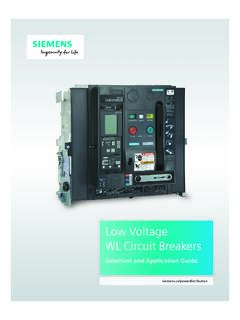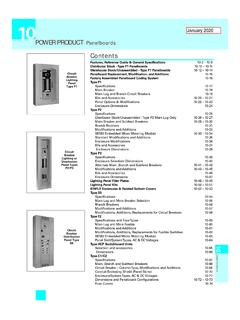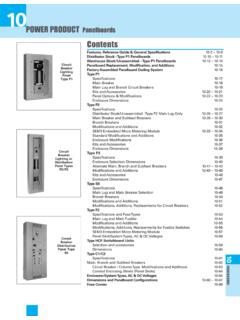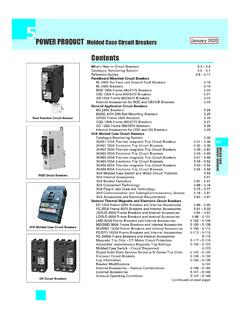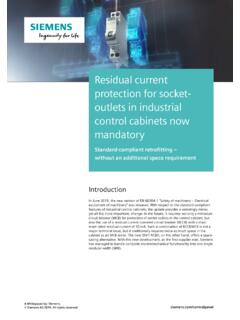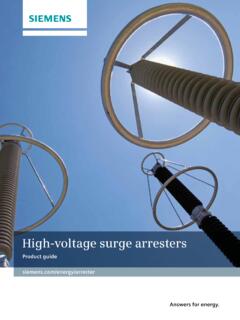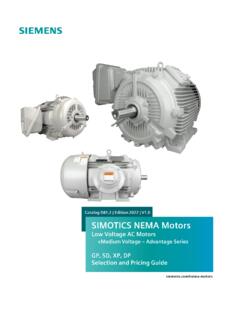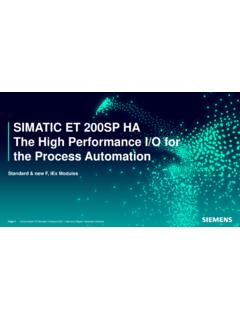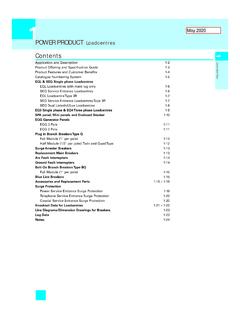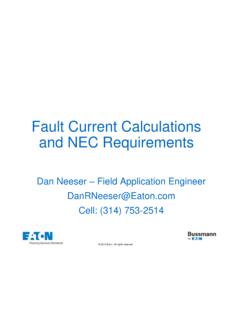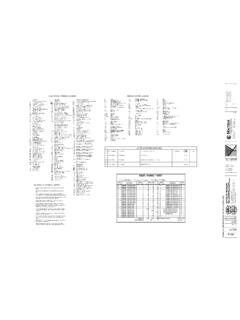Transcription of Type 1 and Type 2 coordination - Siemens
1 Type & quot ;1& quot ; and Type & quot ;2& quot ; coordination for contactors and motor starters acc. to UL 60947-4-1. White Paper I May 2018. Due to market requirements in North America for more harmonization, the standard UL 508 for industrial control equipment has been symphonized with selected sections of the IEC 60947 standard for low- voltage switchgear and controlgear. UL published the new harmonized standards for North America in 2007: UL 60947-1. This standard addresses coordination between the branch circuit protective device and the motor starter and differentiates between Type & quot ;1& quot ; and Type & quot ;2& quot ; coordination types .
2 A white paper from: Siemens . Siemens AG 2018. All rights reserved White paper | Type 1 and Type 2 coordination for contactors and motor starters acc. to UL 60947 -4-1 | May 2018. Content 3 What's behind Type & quot ;1& quot ; and Type & quot ;2& quot ;. coordinated equipment? 3 Introduction 3 Type & quot ;1& quot ; coordination 3 Type & quot ;2& quot ; coordination 3 Testing 4 Origin and background of different coordination types 5 What are the benefits of Type & quot ;2& quot ; coordinated equipment? 5 Increased productivity 5 Cost savings 5 Siemens Type & quot ;2& quot ; coordination rated equipment 6 Can IEC 60947-4-1 based ratings be used instead of UL 60947-4-1 based ratings for Type & quot ;1& quot ; and Type & quot ;2& quot ;?
3 7 Is there a transition period between UL 508 and UL 60947-4-1 standards for industrial control equipment? 8 How can users of contactors and motor starters figure out which components already comply with UL 60947-4-1? 8 Additional references 9 Further information from Siemens A white paper from: Siemens . Siemens AG 2018. All rights reserved 2. White paper | Type 1 and Type 2 coordination for contactors and motor starters acc. to UL 60947 -4-1 | May 2018. What's behind Type & quot ;1& quot ; and Type & quot ;2& quot ;. coordinated equipment? Introduction starter shall cause no danger to persons or installations and shall be suitable for further use.
4 There is a risk of contact For many years, the UL 508 Standard for Industrial Control welding. Equipment has been the standard for control products such as contactors, self-protected combination motor In this case, the manufacturer shall indicate the measures to controllers and overload relays. be taken as regards the maintenance of the equipment. The starter is still operative. There must be no signs of damage To fulfill the demand for stronger harmonization on the to the devices, with the exception of slightly welded North American market, the UL certification organization contactor contacts that can be easily separated again collaborated with members of industry to harmonize UL.
5 Without any noticeable deformation. 508 with selected sections of the IEC 60947 series of standards for low- voltage switchgear and controlgear. Consequence: After a short- circuit , the starter must still be suitable for further operation. There risk of contact welding UL published the new harmonized standards for North ( on a contactor) is acceptable. In this case, the America in 2007: manufacturer's instructions must be followed in order to UL 60947-1: Low- voltage Switchgear and easily separate the welded contacts. Controlgear Part 1: General Rules Regardless of the selected coordination type, a short- circuit UL 60947-4-1: Electromechanical Contactors and will be reliably and safely cleared and disconnected.
6 Since Motor-Starters Part 4-1 coordination Type & quot ;2& quot ; assemblies are often instantly available for further operation after a short- circuit , they can The latter is harmonized to the greatest extent possible with be regarded as higher-quality modules. the IEC 60947-4-1 standard (Contactors and Motor-Starters - Electromechanical Contactors and Motor-Starters), whereby Note: the deviations for North America are set out in UL 60947-4- Combinations of coordination Type & quot ;1& quot ; are generally the 1. This standard is a tri-national standard for the USA, more favorably priced combinations. Canada and Mexico.
7 Combinations of coordination Type & quot ;2& quot ; automatically fulfill UL 60947-4-1 addresses coordination between the branch the requirements of coordination Type & quot ;1& quot ;. circuit protective device and the motor starter, and differentiates between Type & quot ;1& quot ; co-ordination and Type & quot ;2& quot ; Testing co-ordination. It also provides a method for evaluating the short- circuit performance of these devices. All of the specified combinations in the available tables are tested in compliance with UL 60947-4-1 by the original According to UL 60947-4-1, the coordination type defines manufacturer Siemens . You can download official UL.
8 The permissible degree of damage for a device if a short certificates (Certificates of Compliance) from the Siemens circuit occurs. Component combinations must be selected Industry Online Support Portal: according to the desired coordination Type & quot ;1& quot ; or Type & quot ;2& quot ;. coordination Type & quot ;1& quot ;. Definition as per UL 60947-4-1: Type & quot ;1& quot ; coordination requires that under short- circuit conditions the contactor or starter shall cause no danger to persons or installations and does not need to be suitable for further service without repair and replacement of parts. Consequence: After a short- circuit , it is permissible for the starter to be inoperative.
9 In particular, damage to the contactor, solid-state switching devices and overload relay is permissible. coordination Type & quot ;2& quot ;. Definition as per UL 60947-4-1: Type & quot ;2& quot ; co-ordination requires that under short- circuit conditions the contactor or A white paper from: Siemens . Siemens AG 2018. All rights reserved 3. White paper | Type 1 and Type 2 coordination for contactors and motor starters acc. to UL 60947 -4-1 | May 2018. Origin and background of the introduction of coordination types The concept of Type & quot ;1& quot ; and & quot ;2& quot ; coordinated equipment originally came from Europe. Users of industrial control equipment wanted the manufacturer of the short- circuit protective device to specify the protective device to be used for the individual starter.
10 And they wanted to know how a short- circuit would affect the further usability of the industrial control equipment. For this reason, manufacturers performed short- circuit tests with selected short- circuit protective devices. Based on the test results, the degree of damage for the respective starter in combination with specified short- circuit protective devices at a defined voltage was determined. The associated short- circuit protective device had to be specified since equipment devices based on IEC standards is usually designed very close to their maximum capacities. This leads to different electrical ratings between various manufacturers.
